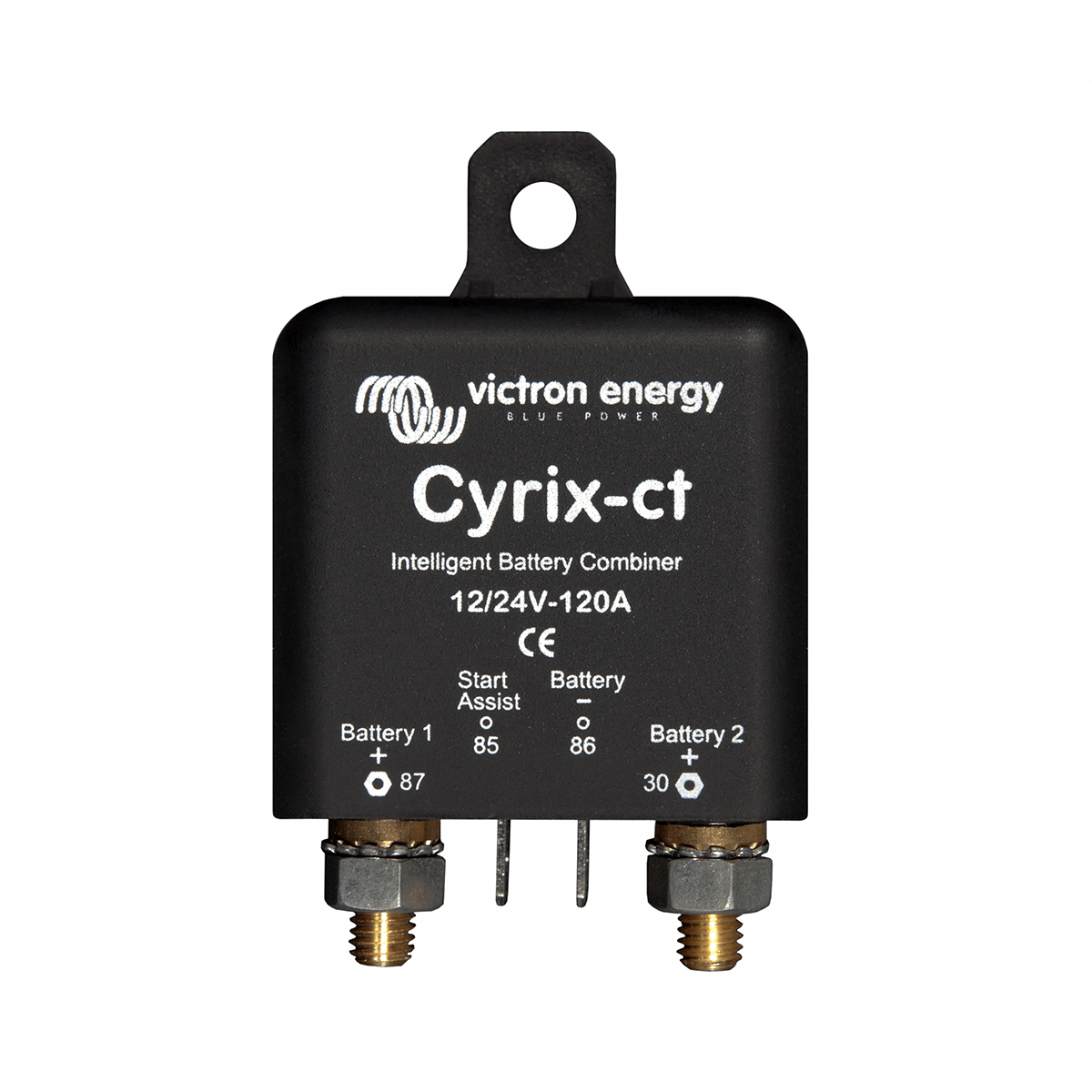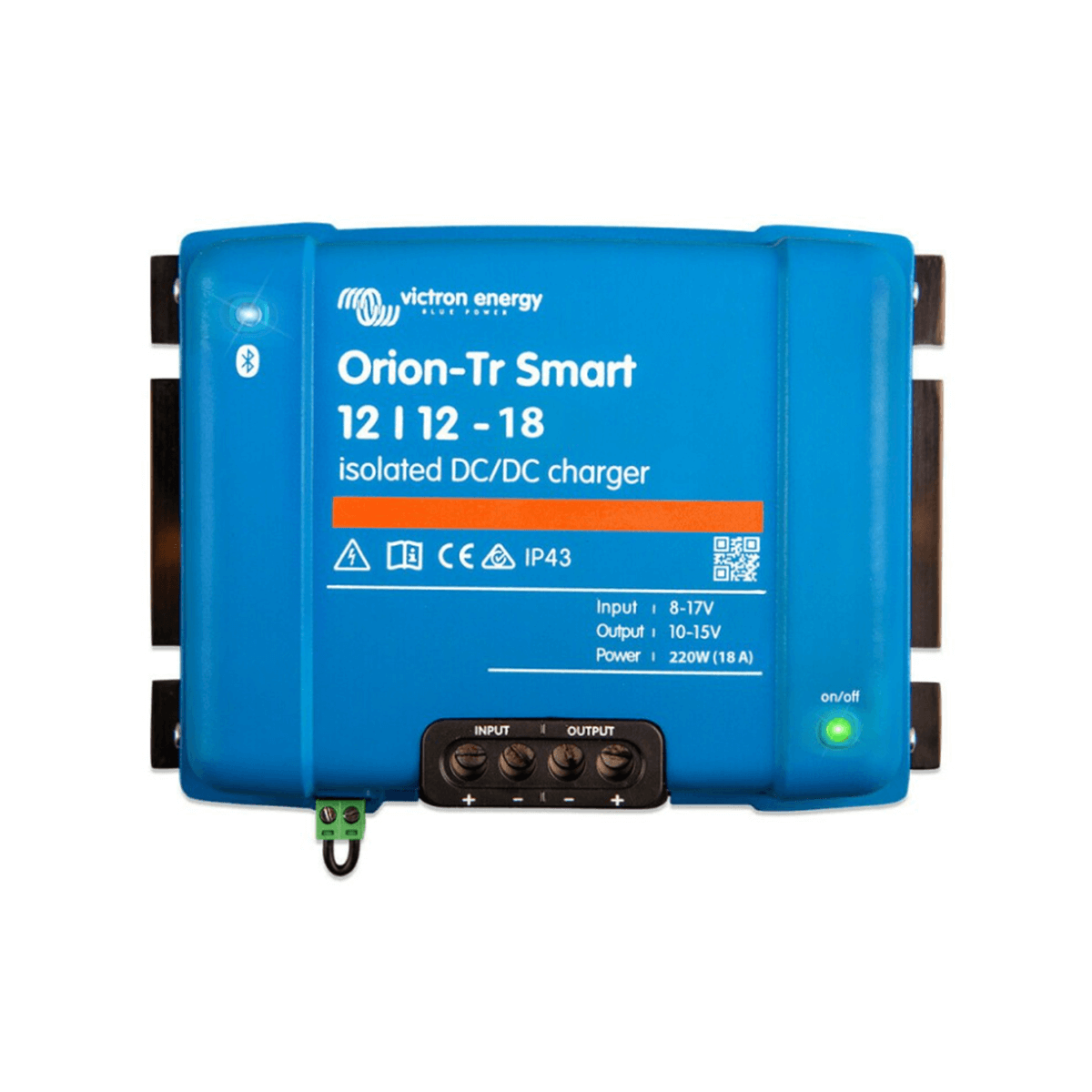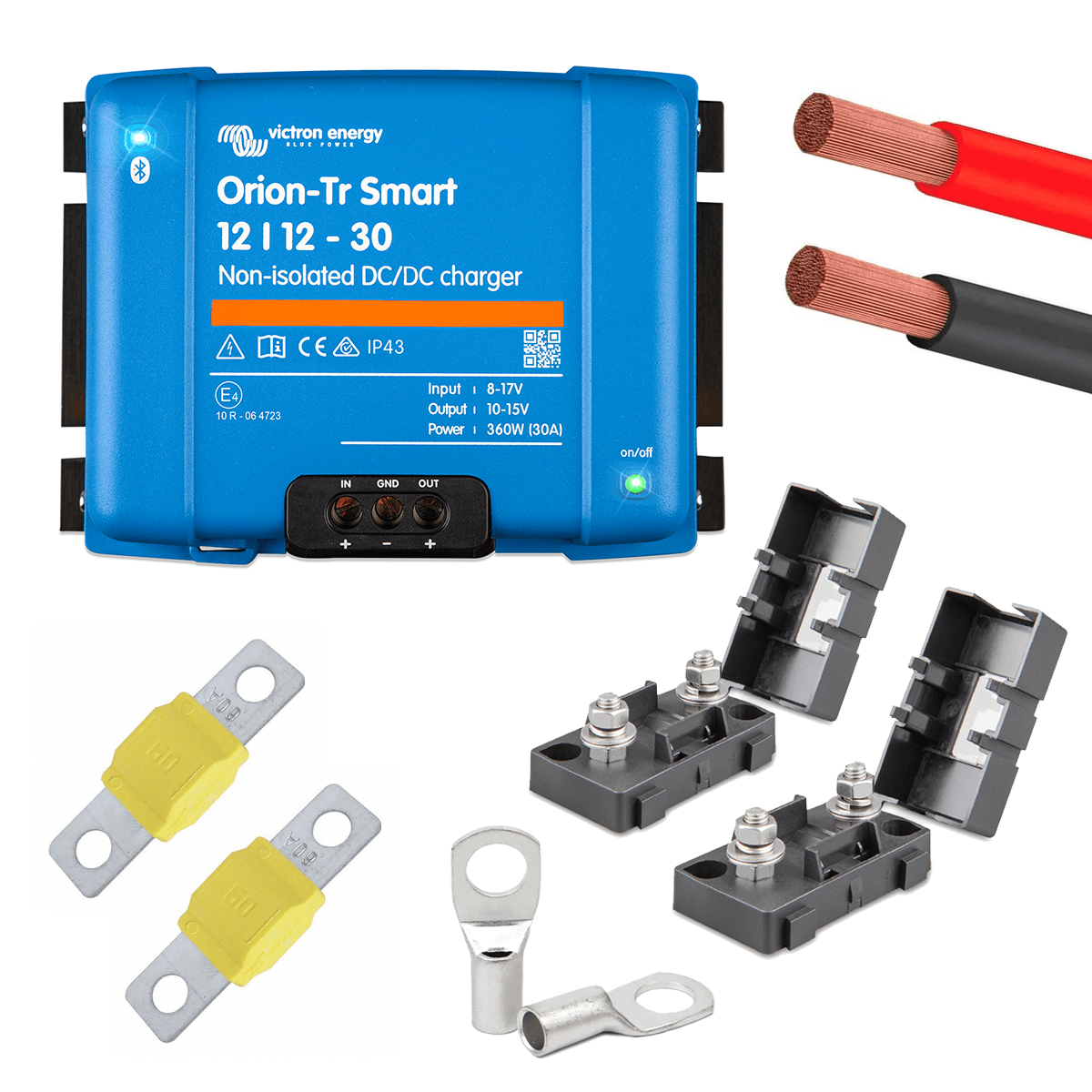Split charge relay – do you need one for your campervan?
Split charge relays are a great way to charge your leisure battery from the power of your engine, but they have their limitations and may not be the best choice for your campervan or boat’s electrical system. Here’s all you need to know about how they work, how to install one and what other options are available.
How does a split charge relay work?
A split charge relay is installed in a campervan or boat to allow a secondary (i.e. leisure) battery to automatically charge whenever the engine is running. Most off-grid electrical set-ups will use a few different methods of charging (split-charging, solar panels, shore power) but split-charging is the one you can always rely on when you’re running low on charge; even if the skies are cloudy and you’re miles away from mains hook-up, you can always go for a drive to top up the battery bank. They are such a useful part of your campervan electrics and are relatively simple to understand and to install.
The vehicle’s starter battery is usually charged from the alternator which generates electricity from the movement of the engine.
Split-charging is the process of sharing that charging power between the vehicle’s starter battery and a secondary battery. A split charge relay acts just like a switch and is installed in-line between the two batteries.
There are a few different types of split charge relay available, all with their own pros and cons. The most popular is called a voltage sensitive relay, or VSR. This type of relay does exactly what it says on the tin, and automatically connects the two batteries when a certain voltage range is detected.
When your vehicle engine is turned on, the alternator begins to rotate and produces a voltage around 14V which charges the starter battery. The voltage sensitive relay is designed to close its contacts when it detects this high voltage across the starter battery – usually at around 13.8V. This allows current to flow from the starter battery into the leisure battery when the engine is running. When the engine is turned off, the voltage from the alternator will drop and the VSR disconnects the batteries at a lower threshold of around 12.8V. This ensures the starter battery isn’t connected to the campervan electrics and can’t be accidentally drained flat.
Tapping into the vehicle’s starter battery may seem a little daunting, but in reality, wiring in a voltage sensitive relay is one of the easiest electrical installations to take on! All you have to do is find your vehicle’s starter battery and run a few chunky cables back to your leisure battery. Well, okay, there’s a bit more to it than that, but we’ll show you what you need to know with a split charge relay wiring diagram.
Want to know more about how to wire a campervan electrical system? We’ve covered all the basics all in this one article.
Can I use a split charge relay with a smart alternator?
Modern vehicles which are Euro 5 and Euro 6 compliant have a smart alternator (sometimes called a variable voltage alternator) which is controlled by the vehicle’s engine control unit (ECU). This means that the alternator doesn’t produce a constant 14V, but instead quickly drops down to a lower voltage before the starter battery is fully charged. This means that a voltage sensitive relay won’t be able to charge a leisure battery in any vehicle that has a smart alternator.
Some smart alternators also charge the starter battery by harvesting the excess energy from braking – called regenerative braking. This creates high peaks in voltage from the alternator (15V+) which can damage a leisure battery. Lithium, AGM and gel batteries are all sensitive to overcharging and high voltages can form gas bubbles which causes damage and shortens their lifespan. This means that you can’t use a voltage sensitive relay if your vehicle has a smart alternator.
How do I know if my vehicle has a smart alternator?
If your vehicle is Euro 5 or Euro 6 compliant, it almost definitely has a smart alternator. Almost all vehicle’s registered after September 2013 are Euro 5 or above. The Euro status can also be found on your vehicle’s V5C, or by checking your vehicle’s details on a website like car check details. If you’re still not sure – there are two other tells.
Vehicles with smart alternators have a small module on the starter battery’s negative terminal – this reads the current through the cable and feeds it back to the alternator.
You can also read the voltage across your leisure battery with a voltmeter (an essential bit of kit for DIY van electrics) in a simple test: Turn your engine on and make sure the radio, lights, and fans are turned off. Read the voltage across your starter battery with a voltmeter. It should be around 14V but after 10 minutes or so, it will drop down to 12.5-13.5V if you have a smart alternator. If it remains at ~14V, you have a standard alternator.
Can I use a split charge relay with a lithium leisure battery?
If you’re planning to install a lithium leisure battery, or you’re swapping out your current lead acid battery for a shiny new lithium one, you won’t be able to use a split charge relay.
Firstly, lithium batteries and alternators don’t get along. In comparison to lead acid, lithium batteries have a very low internal resistance and will draw much higher currents from the alternator. These high currents create a risk not only to the lithium battery, but also to the alternator itself. The amperage pulled by a lithium battery can exceed the alternator’s maximum rated amperage which can cause the alternator to degrade and overheat, especially at low rotational speeds (e.g. when the engine is in idle) since alternators self-cool with their own rotating parts.
Secondly, lithium batteries don’t get along with lead acid batteries! The two battery types actually have slightly different voltages, charging profiles and charge limits, but when a split charge relay is closed, the batteries are directly connected. It’s never advisable to connect batteries of different chemistries; the charge and discharge will be unbalanced, their lifespan will be shortened and you won’t get the most out of their Ah capacity.
Finally, charging any battery from a basic power source, such as an alternator, is not efficient and will never fully charge the battery. Batteries will last longer and charge more efficiently if they are charged in a specific pattern, called a charging profile. There are three main phases of charging: bulk, absorption and float. The ‘absorption’ phase of charging ensures your battery is fully charged, but a split charge relay isn’t capable of this.
If you’ve invested in a quality new Lithium, AGM or gel battery, you want to access its full capacity and make it last as long as possible. Luckily, the correct charging profile can be achieved with a more intelligent method of charging from the alternator, called a battery to battery charger.
Not sure whether a lithium battery is right for you? We’ve gone into detail about the pros and cons of lithium leisure batteries and whether they’re worth that extra big price tag!
Split charge relay vs battery to battery charger
If you can’t use a voltage sensitive relay because you have a smart alternator or a lithium leisure battery, battery to battery chargers, sometimes known as B2B chargers or DC-DC converters, are a more sophisticated alternative.
Intelligent charging
Battery to battery chargers are more expensive, but also provide a far more intelligent charging pattern. They convert the power from the alternator by transforming the voltage and current to produce the correct charging profile for the leisure battery. As previously mentioned, ideal charging profiles typically follow three stages of charging: bulk, absorption and float.
- Bulk: a fast, constant current charge up to ~80% State of Charge (SoC)
- Absorption: much slower, constant voltage charge to reach 100% SoC
- Float: a constant voltage charge which maintains 100% SoC by counteracting self-discharge
Different types of leisure battery need slightly different charging profiles and good quality battery to battery chargers can be programmed to cater for the specific battery type. Charging from the alternator with a voltage sensitive relay won’t achieve this charging pattern and the leisure battery will never be fully charged.
Charging speed
Since the alternator can provide high, unregulated currents, a VSR might charge faster than a B2B, but this isn’t always a good thing. Faster discharges shorten the lifespan of the battery and the lack of current regulation means the battery won’t receive those crucial float and absorption charges which achieve a full charge. A lack of voltage regulation could also lead to overcharging, where the redundant energy is turned into heat and the battery begins to gas. A battery to battery charger is designed to provide the ideal charging speed for the battery.
Price
There is a difference in price between B2B chargers and VSRs. Most 12V voltage sensitive relays are around £40, whereas B2Bs are around £150-250 depending on the brand and the rated amperage.
However, it’s important to remember that there’s more to cost than just the main component. There are a number of other required components to install a voltage sensitive relay or battery to battery charger in your electrical system such as fuses, cables and lugs.
As the voltage sensitive relay is able to charge at a much higher current, this means that it also needs much thicker cable gauge than the battery to battery chargers (you can use the Blue Sea cable gauge calculator to work out exactly what gauge cable you need for certain current ratings at different cable lengths).
Compare the price of our voltage sensitive relay kit over a 9m length (required for most medium and long wheel base vans) to the price of our battery to battery charger kit using the 18A isolated B2B charger over a 9m length. The VSR kit is £177.70 and the B2B kit is £237.98. Originally, when comparing these two components it would seem like the Cyrix-ct is a whopping 72% cheaper. However, once we include all of the other required components to install them, the VSR works out at only 25% cheaper.
Additionally, the high current from the voltage sensitive relay setup will affect the rest of your system, such as the required rating for busbars and switches, so you may well find that the two work out costing the same overall.
If you think a battery to battery charger is the right choice for you, we have some advice on choosing the right battery to battery charger.
Installation
Most voltage sensitive relays and battery to battery chargers are relatively simple to install, but some B2B chargers require one extra step which can prove much trickier. These chargers depend on a signal from the vehicle’s ignition circuit to prompt the beginning and end of the charging process. This involves finding and tapping into the correct wire in your vehicle’s electrics, which can be a little tricky if you haven’t worked on car electrics before, especially as this is usually in a different spot for every single vehicle!
Victron’s Orion-Tr Smart DC-DC chargers don’t use this extra sensing cable; they have a built-in engine shutdown detection which simply anticipates the state of the engine based on the voltage across the starter battery (like a VSR) and so are much simpler to install.


Do I need a VSR or a battery to battery charger?
Voltage sensitive relays are the cheaper option and will do the job in certain cases, if you have an older vehicle without a Euro 5 or Euro 6 engine and you are on a lower budget. However, we would always recommend installing a battery to battery charger, as they will ensure your leisure batteries are always fully charged. It’s important to remember that you can’t use a VSR if you have a smart alternator or a lithium leisure battery.
Split charge relay wiring diagram
This wiring diagram shows how to connect a split charge relay (specifically a voltage sensitive relay) as part of your campervan electrical system. The positive cable should be fused both on the starter battery side and the leisure battery side of the system. It’s important that this is installed as close to the battery as possible.
We would recommend including a kill switch next to the positive bus bar as this allows you to isolate each individual part of your electrical system.
We’d always recommend that you get your electrical system checked by a professional before starting to use it.
Split charge relay kit
Do you want to install a split charge relay but you’re not sure what you need? Our split charge relay kit include every single component you need to successfully install a voltage sensitive relay as part of your campervan electrical system.
Still not sure whether you need a VSR or a B2B charger? Need some help with the rest of your electrical system? Try out our free electrical system design service where we’ll do all the calculations for you! All you need to do is answer a series of questions about your usage and we’ll take care of the rest. We provide a bespoke proposal for your system for free, and if you purchase your components through us, we’ll also give you a free bespoke wiring diagram.
Campervan electrics leaving you confused?







 Wiring diagram included
Wiring diagram included

Thanks for the article, but my question isn’t covered here! We have an AGM battery with this manufacturer specification: “Maximum Charge Current (String) 60 A” If we purchased a Victron Cyrix 120a charger doesn’t this mean we would be charging our leisure battery at twice its maximum charging current!? We don’t have a smart alternator so no worries there. Can’t seem to find mention of this potential issue online, is it because most people are running multiple batteries in parallel increasing the maximum charge rate?
Many thanks!
Hi Harry, thanks for your message. Please can you advise what capacity your AGM battery is? Although its max charge current may be 60A, the likelihood is it should be charged at a lower current to prolong its lifespan. You should charge AGM batteries at 10-20% of their total capacity each hour (e.g. a 100Ah AGM battery should be charged at ~10A/hr to prolong its lifespan, but up to ~20A/hr shouldn’t have too much of a negative impact). Anything over this and you will start to decrease the lifespan of the battery. So if you try to charge your battery with the Cyrix 120A, you will significantly shorten its lifespan as it’s not designed to charge this quickly. This is one of the benefits of lithium batteries, that they can be charged much quicker than AGM batteries.
So using my example above, if you have a 100Ah battery, then you should be looking for a charger no bigger than 20A. For example, the Victron Orion 18A B2B would be suitable in this case.
Hope that helps!